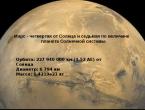Make a presentation on the topic of the planet Mars. Presentation - Mars - the mysterious red planet. Mars is a terrestrial planet with a thin atmosphere
Slide 1
Mars - the mysterious red planet
pptforschool.ru
Slide 2

The biggest mystery for humanity remains everything that is outside our planet. How much unknown and undiscovered dark space conceals within itself. I am glad that today we know information, albeit not all, about nearby planets. Let's talk about Mars today.
Slide 3

Mars is the fourth planet farthest from the Sun and closest to Earth. This planet is approximately 4.6 billion years old, like Earth, Venus and the rest of the planets in the solar system. The name of the planet comes from the name of the ancient Roman and Greek god of war - ARES. The Romans and Greeks associated the planet with war due to its resemblance to blood. When viewed from Earth, Mars is red-orange in color. The color of the planet is due to the abundance of iron minerals in the soil.
Slide 4

Orbit and rotation of the planet. Like the rest of the planets in the solar system, Mars revolves around the Sun in an elliptical orbit. But its orbit is more elongated than the orbit of the Earth and other planets. The greatest distance from the Sun to Mars is 249,230,000 km, the smallest is 206,620,000 km. The length of the year is 687 Earth days. The length of a day is 24 hours 39 minutes and 35 seconds. The distance between Earth and Mars depends on the position of these planets in their orbits. It can vary from 54,500,000 km to 401,300,000 km. Mars is closest to Earth during opposition, when the planet is in the opposite direction to the Sun. Oppositions are repeated every 26 months at different points in the orbit of Mars and Earth.
Slide 5

Physical characteristics of Mars
Mass and density. The mass of Mars is 6.42*1020 tons, which is 10 times less than the mass of the Earth. Density is about 3.933 grams per cubic centimeter, which is approximately 70% of the density of the Earth. Gravitational forces. Due to the planet's smaller size and density, the gravity on Mars is 38% that of Earth. Therefore, if a person stands on Mars, he will feel as if his weight has been reduced by 62%. Or, if he drops a stone, then this stone will fall much more slowly than the same stone on Earth.
Slide 6

Sources of obtaining information about Mars are: calculations related to the mass, rotation, density of the planet, knowledge of the properties of other planets, analysis of Martian meteorites that fell to Earth, as well as data collected from research vehicles in orbit of the planet. All this information makes it possible to assume that Mars, like the Earth, may consist of 3 main layers: the Martian crust; mantle; a core consisting mainly of iron.
Slide 7

Surface of Mars
Plains. Most of the surface consists of flat, low-lying plains, which are mainly located in the northern hemisphere of the planet. One of these plains is the lowest and relatively smooth among all the plains in the solar system. This smoothness was likely achieved by deposits of sediment (tiny particles that settle at the bottom of liquid) formed as a result of water in the area - one piece of evidence that there was once water on Mars.
Slide 8

Surface of Mars
Canyons. Along the planet's equator lies one of the world's most stunning sites, a system of canyons known as Valles Marineris, named after the Marinera 9 space research station that first discovered the valley in 1971. Valles Marineris stretches from east to west and is approximately 4000 km in length, which is equal to the width of the continent of Australia. Scientists believe that these canyons were formed as a result of the splitting and stretching of the planet's crust; the depth in some places reaches 8-10 km.
Valle Marineris
Slide 9

Valles Marineris on Mars. Photo from astronet.ru
Slide 10

Volcanoes of Mars
The largest volcano in the solar system is located on Mars - the Olympus Mons volcano (translation from Latin: Mount Olympus) with a height of 27 km. The diameter of the mountain is 600 km. Three other large volcanoes - Mounts Arsia, Askreus and Povonis - are located on a huge volcanic highland called Tharsis. All the slopes of the volcanoes on Mars gradually rise, similar to the volcanoes in Hawaii. Hawaiian and Martian volcanoes are wall volcanoes formed from lava eruptions. Currently, not a single active volcano has been found on Mars. Traces of volcanic ash on the slopes of other mountains suggest that Mars was once volcanically active.
Slide 11

volcano Olympus Mons
Slide 12

Climate and atmosphere of Mars
Atmosphere. The atmosphere of Mars is thin, the oxygen content in the atmosphere is only 0.13%, while in the Earth's atmosphere it is 21%. Carbon dioxide content - 95.3%. Other gases contained in the atmosphere include nitrogen - 2.7%; argon - 1.6%; carbon monoxide - 0.07% and water - 0.03%. Atmosphere pressure. The atmospheric pressure on the planet's surface is only 0.7 kPascal, which is 0.7% of the atmospheric pressure on the Earth's surface. As the seasons change, atmospheric pressure fluctuates. Temperature of Mars. At high altitudes in the region of 65-125 km from the surface of the planet, the atmospheric temperature is -130 degrees Celsius. Closer to the surface, the average daily temperature of Mars ranges from -30 to -40 degrees. Just below the surface, the temperature of the atmosphere can vary greatly throughout the day. Even near the equator, it can reach -100 degrees late at night.
Slide 13

Dust storms
A dust storm is the most spectacular weather event on Mars. This is a swirling wind that can lift dust from the surface in a short time, which looks like a tornado.
The formation of large dust storms on Mars occurs as follows: when strong winds begin to lift dust into the atmosphere, this dust absorbs sunlight, thereby warming the air around it. As soon as warm air rises, an even stronger wind arises, which raises even more dust. As a result, the storm becomes even stronger.
Slide 14

Is there life on Mars?
Scientists believe that Mars has three main components necessary for life: chemical elements such as carbon, hydrogen, oxygen and nitrogen, which form organic elements; a source of energy that can be used by living organisms; water in liquid form.
Slide 15

Is there life on Mars?
Researchers suggest: if there was once life on Mars, then living organisms can exist today. As evidence, they cite the following arguments: the basic chemical elements necessary for life were likely present on the planet throughout its history. The source of energy could be the sun, as well as the internal energy of the planet itself. Water in liquid form could also exist, since canals, ditches and a huge amount of ice, more than 1 m high, were discovered on the surface of Mars. Consequently, water can still exist in liquid form under the surface of the planet. And this proves the possibility of the existence of life on the planet.
To use presentation previews, create a Google account and log in to it: https://accounts.google.com
Slide captions:
Is there life on Mars? This is unknown to science. Bye.
A little about Mars. Mars is the fourth most distant planet from the Sun and the seventh largest planet in the solar system. This planet is named after Mars, the ancient Roman god of war, corresponding to the ancient Greek Ares. Mars is sometimes called the "Red Planet" due to the reddish hue of the surface given to it by iron oxide.
Basic information. Mars is a terrestrial planet with a thin atmosphere. Features of the surface relief of Mars can be considered impact craters like those on the Moon and volcanoes, valleys, deserts and polar ice caps like those on Earth. The Martian extinct volcano Mount Olympus is the highest mountain in the Solar System, and Valles Marineris is the largest canyon. Mars has two natural satellites, Phobos and Deimos (translated from ancient Greek as “fear” and “terror” - the names of the two sons of Ares who accompanied him in battle), which are relatively small and irregular in shape.
Physical characteristics. Mars is almost half the size of Earth - its equatorial radius is 3396.9 km (53.2% of Earth's). The surface area of Mars is approximately equal to the land area on Earth. A Martian year consists of 668.6 Martian solar days (called sols). The tilt of Mars' rotation axis causes the seasons to change.
Atmosphere and climate. The temperature at the planet's equator ranges from +30 °C at noon to −80 °C at midnight. Near the poles, the temperature sometimes drops to −123 °C. The atmosphere of Mars, consisting mainly of carbon dioxide, is very thin. The pressure at the surface of Mars is 160 times less than that on Earth. Unlike Earth, the mass of the Martian atmosphere varies greatly throughout the year due to the melting and freezing of the polar caps containing carbon dioxide. There is evidence that in the past the atmosphere may have been denser, the climate warmer and wetter, and there was liquid water and rainfall on the surface of Mars. The atmosphere consists of 95% carbon dioxide; it also contains 2.7% nitrogen, 1.6% argon, 0.13% oxygen, 0.1% water vapor, 0.07% carbon monoxide.
Surface. Thanks to space expeditions to Mars, today we have a detailed map of its surface and accurate astronomical data about it.
Water on Mars?! In early 2001, MGS completed its main mission: within one Martian year, it transmitted to Earth a detailed survey of the entire surface of Mars. And now I have begun a detailed study of particularly interesting areas. Images of the modern surface indicate that there were eras on Mars when water played a particularly significant role on the planet. Branched valleys resembling dried up river beds, layered formations in the Valles Marineris, and the sand dunes of Proctor Crater are the most striking examples of this. Open bodies of water cannot exist on Mars - the temperature there is too low and the atmosphere is too thin to contain liquid water; however, water is still present.
Priming. The elemental composition of the surface layer of Martian soil, according to data from landers, is not the same in different places. The main component of the soil is silica (20-25%), containing an admixture of iron oxide hydrates (up to 15%), giving the soil a reddish color. According to data from NASA's Phoenix Mars Lander probe (landing on Mars on May 25, 2008), the pH ratio and some other parameters of Martian soils are close to those on Earth and theoretically it would be possible to grow plants on them.
Bacteria in meteorites. Recently, Martian meteorites found in different parts of our planet have attracted the close attention of scientists. Crystals of the mineral magnetite in a meteorite discovered in Antarctica provide evidence that primitive life existed.
However, the question of whether there is life on Mars remains unresolved. Perhaps more convincing evidence will be obtained later, when a sample of Martian soil is delivered to Earth. But most likely, the solution to the problem will be postponed until a human flight to Mars, when it will be possible to deliberately select the substance from the sedimentary layers with a detailed description of the sampling site. The discovery of a Martian biosphere, modern or extinct, would be one of the greatest discoveries in the history of science.
But what about the answer to our main question? Is there life on Mars? In our earthly understanding (if there is life, then it must be thinking; if it is thinking, it must be humanoids) there is no life on the planet.
- Mars is the fourth most distant planet from the Sun and the seventh largest planet in the solar system. This planet is named after Mars, the ancient Roman god of war, corresponding to the ancient Greek Ares. Mars is sometimes called the “Red Planet” because of the reddish hue of its surface given by iron(III) oxide.
- Sidereal period 686.971 days
- 1.8808 years
- Synodic period 779.94 days
- Orbital speed 24.13 km/s (average)
- Inclination 1.85061° (relative to
- ecliptic plane)
- 5.65°(relative
- solar equator)
- Mars is a terrestrial planet with a thin atmosphere. Features of the surface relief of Mars can be considered impact craters like those on the Moon and volcanoes, valleys, deserts and polar ice caps like those on Earth. The Martian extinct volcano Olympus Mons is the highest mountain in the solar system, and Valles Marineris is the largest canyon.
- Due to low pressure, water cannot exist in a liquid state on the surface of Mars, but it is likely that conditions were different in the past, and therefore the presence of primitive life on the planet cannot be ruled out. On July 31, 2008, water in an ice state was discovered on Mars by NASA's Phoenix spacecraft.
- Mars has two natural satellites, Phobos and Deimos, which are relatively small and irregular in shape.
- Phobos Deimos
- Mars is almost half the size of Earth. The planet's mass is 6.418×1023 kg (10% of the Earth's mass). The acceleration of gravity at the equator is 3.711 m/sec². The planet's rotation period is 24 hours 37 minutes 22.7 seconds. Thus, a Martian year consists of 668.6 Martian solar days (called sols). The tilt of Mars' rotation axis causes the seasons to change.
- The temperature at the planet's equator ranges from +30 °C at noon to −80 °C at midnight. Near the poles, the temperature sometimes drops to −143 °C. The atmosphere of Mars, consisting mainly of carbon dioxide, is very thin. The pressure at the surface of Mars is 160 times less than on Earth - 6.1 mbar at the average surface level.
- The polar caps consist of two components: seasonal - carbon dioxide and secular - water ice. The Mars Odyssey probe discovered active geysers on the southern polar cap of Mars. The spring melting of the polar caps leads to a sharp increase in atmospheric pressure and the movement of large masses of gas to the opposite hemisphere. The wind lifts large amounts of dust from the surface, leading to dust storms.
- During sunrise and sunset, the Martian sky at the zenith has a reddish-pink color, and in the immediate vicinity of the solar disk - from blue to violet, which is completely opposite to the picture of earthly dawns.
- Noon on Mars. Photo of the Pathfinder
- Sunset on Mars.
- Photo of the Pathfinder














1 of 14
Presentation on the topic: Mars
Slide no. 1

Slide description:
Slide no. 2

Slide description:
Mars Mars is a terrestrial planet with a thin atmosphere. Features of the surface relief of Mars can be considered impact craters like those on the Moon and volcanoes, valleys, deserts and polar ice caps like those on Earth. Mars has a rotation period and seasons similar to those on Earth, but its climate is much colder and drier than Earth's. The Martian extinct volcano Olympus Mons is the highest mountain in the solar system, and Valles Marineris is the largest canyon. In June 2008, three papers published in Nature provided evidence for the largest known impact crater in the solar system in the northern hemisphere of Mars. It is 10,600 km long and 8,500 km wide, about four times larger than the largest impact crater near its south pole on Mars.
Slide no. 3

Slide description:
Comparative size of the Earth and Mars Mars is almost half the size of the Earth - its equatorial radius is 3396.9 km (53% of the Earth's). The surface area of Mars is approximately equal to the land area on Earth. The polar radius of Mars is approximately 21 km less than the equatorial radius. The planet's mass is 6.418×1023 kg (11% of the Earth's mass). The acceleration of gravity at the equator is 3.693 m/sec² (0.378 Earth); the first escape velocity is 3.6 km/sec and the second is 5.027 km/sec. Mars rotates around its axis, inclined to the orbital plane at an angle of 24°56′ with a period of 24 hours 37 minutes 22.7 seconds. A Martian year consists of 668.6 Martian solar days (called sols). The tilt of Mars' rotation axis causes the seasons to change. In this case, the elongation of the orbit leads to large differences in their duration. Thus, the northern spring and summer, taken together, last 371 sols, that is, noticeably more than half of the Martian year. At the same time, they occur in a section of Mars’ orbit that is distant from the Sun. Therefore, on Mars, the northern summer is long and cool, and the southern summer is short and hot.
Slide no. 4

Slide description:
Mars moves around the Sun in an elliptical orbit with an eccentricity of 0.0934. The orbital plane is inclined to the ecliptic plane at a slight angle (1° 51"). The average distance from the Sun is 227.99 million km (1.524 AU). The minimum distance from the Sun is approximately 207, the maximum is 249 million km; from -due to this difference, the amount of energy received from the Sun varies by 20-30%. Since the inclination of the equator to the orbital plane is significant (25.2°), there are noticeable seasonal changes on the planet. The period of Mars’ revolution around the Sun is almost twice as long as an Earth year (686. 98 Earth days). The average speed of orbital motion is 24.13 km/s. The period of daily revolution of Mars around its axis is almost the same as that of the Earth (24 hours 37 minutes 22.58 s). The equatorial radius of the planet is 3394 km, polar. - 3376.4 km. The surface level in the southern hemisphere is on average 3-4 km higher than in the northern. The mass of Mars is 6.44 1023 kg, that is, 0.108 of the mass of the Earth. The average density is 3.95 g/cm3. fall at the equator of 3.76 m/s2. Mars is at its minimum distance from the Earth during oppositions that occur at intervals of 779.94 Earth days. However, once every 15-17 years the so-called great opposition occurs, when these two planets approach each other by about 56 million km; the last such approach took place in 1988. During great oppositions, Mars appears as the brightest star in the midnight sky (-2.7 magnitude), orange-red in color, as a result of which it came to be considered an attribute of the god of war (hence the name of the planet). Movement, size, mass
Slide no. 5

Slide description:
The elevation differences are quite significant and amount to approximately 14-16 km in the equatorial region, but there are also peaks that rise much higher, for example, Arsia (27 km) and Olympus (26 km) in the elevated Tarais region in the northern hemisphere. Observations of Mars from satellites reveal clear traces of volcanism and tectonic activity - faults, gorges with branching canyons, some of them are hundreds of kilometers long, tens of them wide and several kilometers deep. The most extensive of the faults - “Valley Marineris” - near the equator stretches for 4000 km with a width of up to 120 km and a depth of 4-5 km. Surface topography
Slide no. 6

Slide description:
Typographic map of Mars Telescopic exploration of Mars has revealed features such as seasonal changes in its surface. This primarily applies to the “white polar caps,” which begin to increase with the onset of autumn (in the corresponding hemisphere), and in the spring they “melt” quite noticeably, with “warming waves” spreading from the poles. A significant part of the surface of Mars consists of lighter areas (“continents”) that have a reddish-orange color; 25% of the surface is darker “seas” of gray-green color, the level of which is lower than that of the “continents”.
Slide no. 7

Slide description:
Gusev Crater Site Craters The large number of craters in the southern hemisphere suggests that the surface here is ancient - 3-4 billion years old. Several types of craters can be distinguished: large craters with a flat bottom, smaller and younger bowl-shaped craters similar to the Moon, craters surrounded by ridges, and elevated craters. The last two types are unique to Mars - rimmed craters formed where liquid ejecta flowed across the surface, and raised craters formed where a blanket of crater ejecta protected the surface from wind erosion.




